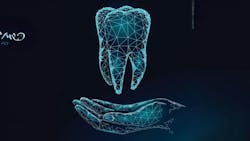9 things every hygienist should know about dental AI
Listen to the article on our podcast!
Dental AI is more than a trend; it’s a transformative tool that even the least techy among us rely on for patients. From AI running in the background of your practice management system, to digital radiographs, virtual therapeutic reality, and chart transcription services, AI empowers dental hygienists to be more accurate, efficient, and patient-focused. Embracing dental AI doesn’t mean losing the human touch. It means amplifying your skills, improving clinical outcomes, and elevating patient care.1
The future of dental AI is yet to be discovered. We know it will allow us to better personalize patients’ clinical care and recommendations through analyzing trends and patterns in health data sets. We know it will help prevent and track disease and allow us to understand what a patient may be genetically at risk for. And we know that in health care, a human professional eye will always be needed to check and double check AI because health care is dynamic, fluid, and still a mystery.
For the last several years I’ve been educating industry pros about dental AI, working closely with technology innovators while holding an executive position in the Dental AI Association. Technology has always fascinated me, professionally and nonprofessionally, though to be honest, it makes me a bit wary.
Every rose has its thorns, and when I speak about dental AI and technology, I often eagerly endorse it while cautioning users about its limitations. This is why it’s important for dental hygienists to dive into the research, products, and pros and cons that come with any innovation.
Here’s a look at the nine things every hygienist should know about dental AI.
1. AI is not new
AI isn’t a futuristic concept; it’s already here. From running your patient management software to patient payment processing, it’s safe to say that anytime you are on a device in your clinical (or personal) day, you’re using AI in some capacity.
2. Dental AI is more than just x-rays
AI-powered computer vision in dental radiographs has been a hot topic for the last several years; however, dental AI usage is much more than simply reading x-rays. In 2022, the American Dental Association Standards Committee on Dental Informatics released White Paper No. 1106, “Overview of Artificial and Augmented Intelligence Uses in Dentistry.” The authors review the ways AI is useful in dental imaging and various other aspects of both the clinical and business sides of the industry.2
3. AI will expedite patient education
One of the biggest challenges we face in the op is regarding patient education. How long do we spend explaining the disease to patients before they take ownership of their health? What visuals do we use? How much time do we spend re-explaining it, only for them to seek a second or third opinion?
In my experience, when a computer or device shows a patient their disease, they often accept it with minimal second-guessing. AI visualizations, such as side-by-side x-ray comparisons and highlighted problem areas, make it easier for patients to grasp the why behind treatment recommendations. Other tools such as salivary, plaque, and genetic testing can also help patients grasp their oral health status.
4. AI allows hygienists to work smarter, not harder
From health screening to analyzing x-rays and other images, to assisting with periodontal and tooth charting, dental AI has begun to automate repetitive tasks and allow us to spend more time on the creative and complex tasks at hand. AI also encourages greater collaboration among the dental team, specialists, and other health-care providers. For example, currently in development are loupes with augmented reality technology in the device. This allows other providers to see what the dental hygienist can see, to draw and note within the hygienist’s visual parameters, and also speak with the hygienist.3
5. AI can help reduce workplace injuries
One little known value with dental AI is that it can help reduce fatigue and workplace injuries. For example, touch-free perio charting listens to and records your notes, reducing your repetitive motion of stopping charting, turning, raising your arm, and typing on the keyboard. Another example of reducing workplace injury is smart earpieces that filter out the harmful noises like the drill and suction. These earpieces also allow audio communication with anyone else in the practice who is wearing them, including patients.4
6. AI can listen and do charting for you
Voice-controlled perio charting has been around for some time via headset, and we’re now seeing an elevated perio charting experience that not only listens and charts while you perio chart but also listens to you during the appointment and writes your chart notes for you. This software streamlines charting, making notes quicker and more consistent and freeing you to focus on patient care.5
7. AI helps prevent, track, and treat disease
Salivary testing has grown from predictive and screening tests that are sent to a lab, to chairside tests that analyze human genetics and prevalence and can diagnose. Remote patient monitoring allows AI software to track periodontal trends over time and alert you and the patient when conditions worsen or change, allowing you to understand the effectiveness of the clinical therapies.
8. Personalization of patient care
Since the start of digital electronic health records and practice management software, patient health data has been collected by these programs. Until now, we haven’t had a way to analyze the data to track trends, patterns, and overall health. With the incorporation of generative AI and better user interfaces, the future of dental AI will allow us to customize clinical care like never before. This translates to personalizing recall intervals, focusing on conditions we know the patient is statistically genetically at-risk for, and educating patients on changes to flag issues before they become severe.
9. Know the limitations of AI
AI use will become even more significant in the next 24 months, but one thing to keep in mind is, as with anything new, we don’t know what we don’t know. We don’t yet know how to fully incorporate these tools into our current workflows, and we don’t yet know how to use these tools to write a comprehensive story of a patient’s health. We do know that in health care we will always need a human professional eye to confirm, analyze, and discover what a computer cannot.
Dental AI truly is the dental hygienists’ friend, albeit a friend with limitations. Over the next several years dental hygienists’ role is set to be transformed because technology will automate mundane tasks we’re used to doing. We’ll finally uncover the mysteries of our patients’ oral health and track disease patterns to understand how effective our clinical care truly is. Most importantly, dental AI is going to get us back to the basics and allow us to do what it cannot—the complex and creative process we know as one-on-one patient care.
Editor's note: This article appeared in the July 2025 print edition of RDH magazine. Dental hygienists in North America are eligible for a complimentary print subscription. Sign up here.
References
- Bell IH, Nicholas J, Alvarez-Jimenez M, Thompson A, Valmaggia L. Virtual reality as a clinical tool in mental health research and practice. Dialogues Clin Neurosci. 2020;22(2):169–177. doi:10.31887/DCNS.2020.22.2/lvalmaggia
- Jagtap R. Dentistry—overview of artificial and augmented intelligence uses in dentistry. American Dental Association. April 2023. https://www.researchgate.net/publication/370204446_Dentistry_-_Overview_of_Artificial_and_Augmented_Intelligence_Uses_in_Dentistry
- Kite-Powell J. This new optical loupe prototype has an augmented reality overlay. Forbes. April 28, 2023. https://www.forbes.com/sites/jenniferhicks/2023/04/28/this-new-optical-loupe-prototype-has-an-augmented-reality-overlay/?sh=60c1c5082dd9
- Noise cancellation and AI-driven wireless communication. Finally Quiet. https://finally-quiet.com/
- Give your hygienists a hand. Denti AI. https://www.denti.ai/
About the Author

Melissa Turner, BASDH, RDHEP, EFDA
Melissa K. Turner, BASDH, RDHEP, EFDA, was honored as a 2024 Marquis Who's Who in America recipient. She is Senior Executive Consultant at Cellerant Consulting Group and spearheads the Cellerant Best of Class Hygiene Awards. She is a founding board member of the American Mobile & Teledentistry Alliance, cochair of the Oral Health Prevention Summit, and serves on the executive board of the Dental AI Association. Known as @thetoothgirl, she is the cofounder of The Denobi Awards and the National Mobile & Teledentistry Conference.


